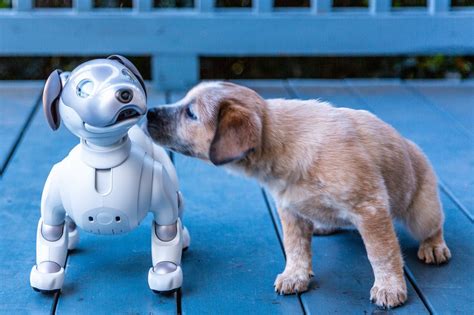Introduction
In the rapidly evolving landscape of technology, the concept of AI robot pets is gaining significant traction as a potential alternative to traditional pets. As we approach 2025, it is imperative to delve into the captivating debate surrounding AI robot pets and traditional pets, exploring their distinct characteristics, advantages, and disadvantages.

AI Robot Pets: A Revolution in Pet Ownership
AI robot pets, powered by advanced artificial intelligence algorithms, offer a myriad of benefits that entice pet owners:
- Convenience: AI robot pets require minimal care and maintenance, eliminating the need for feeding, grooming, and veterinary visits.
- Allergy-Friendly: These pets are hypoallergenic, making them ideal for individuals allergic to traditional pets.
- Interactive and Engaging: Equipped with sensors and processors, AI robot pets respond to interactions, providing companionship and entertainment.
Traditional Pets: A Timeless Value
Despite the allure of AI robot pets, traditional pets continue to hold a special place in many hearts:
- Emotional Bond: Traditional pets offer genuine emotional connections, providing companionship, unconditional love, and a sense of responsibility.
- Health Benefits: Studies have shown that interacting with traditional pets can reduce stress, lower blood pressure, and improve cardiovascular health.
- Socialization: Traditional pets facilitate social interactions, fostering connections between owners and their communities.
A Comparative Analysis of AI Robot Pets and Traditional Pets
| Feature | AI Robot Pets | Traditional Pets |
|---|---|---|
| Convenience | High | Low |
| Allergy-Friendliness | High | Low |
| Interactivity | Customizable | Natural |
| Emotional Bond | Moderate | High |
| Health Benefits | Limited | Significant |
| Socialization | Moderate | High |
| Maintenance Cost | Low | High |
| Lifespan | Indefinite | Finite |
Addressing the Ethical Concerns
The advent of AI robot pets raises ethical concerns that warrant consideration:
- Displacement of Traditional Pets: Mass adoption of AI robot pets could potentially displace traditional pets, reducing the demand for their care and companionship.
- Emotional Depth: While AI robot pets provide companionship, they may not fully replicate the emotional depth of traditional pets.
- Environmental Impact: The production and disposal of AI robot pets could have environmental implications.
Conclusion: A Balanced Approach
Ultimately, the choice between AI robot pets and traditional pets is a personal one that depends on individual preferences, lifestyles, and ethical considerations. By understanding the distinct advantages and disadvantages of both options, we can navigate this evolving landscape and make informed decisions that align with our values and aspirations.
Empowering Pet Owners: A Step-by-Step Guide
- Research and Educate: Explore the various types of AI robot pets and traditional pets, their characteristics, and care requirements.
- Consider Your Needs: Determine your lifestyle, budget, and emotional needs to identify the most suitable option.
- Make an Informed Decision: Based on your research and considerations, make an informed decision that aligns with your preferences and values.
- Stay Engaged: Regardless of your choice, ensure that you provide adequate care and attention to your pet to foster a fulfilling bond.
Highlight: AI Robot Pets for Assisted Living
AI robot pets have emerged as a transformative asset in assisted living facilities:
- Providing Companionship: These pets offer a constant source of companionship, reducing loneliness and enhancing emotional well-being.
- Stimulating Cognition: Interactive AI robot pets engage seniors cognitively, improving their memory and reasoning abilities.
- Reducing Stress: The presence of AI robot pets can help alleviate stress and anxiety, particularly for those with dementia or Alzheimer’s disease.
Current Status and Future Prospects
The market for AI robot pets is poised for significant growth in the coming years:
- Rising Adoption Rates: According to a study by the American Pet Products Association, the adoption of AI robot pets is expected to increase by over 100% by 2025.
- Technological Advancements: Ongoing advancements in AI and robotics will continue to enhance the capabilities and sophistication of AI robot pets.
- Expanding Applications: AI robot pets are finding applications in various fields, including education, healthcare, and entertainment.
Innovation and New Application Ideas
The possibilities for AI robot pets extend far beyond traditional companionship:
- Pet Therapy: AI robot pets can provide therapeutic benefits to individuals with special needs or mental health conditions.
- Education: Interactive AI robot pets can engage students in learning, fostering curiosity and scientific exploration.
- Environmental Monitoring: AI robot pets equipped with sensors can monitor environmental conditions, providing valuable data for research and conservation efforts.
Effective Strategies for Optimizing Pet Care
- Establish a Care Plan: Set up a regular schedule for feeding, grooming, and veterinary check-ups for traditional pets.
- Provide Enrichment: Engage both AI robot pets and traditional pets with toys, puzzles, and interactive activities to stimulate their minds and bodies.
- Monitor Health and Well-Being: Pay attention to your pet’s behavior, appetite, and overall appearance to detect any potential health issues.
- Consider Pet Insurance: Pet insurance can provide financial protection against unexpected veterinary expenses, ensuring that your pet receives the best possible care.





















